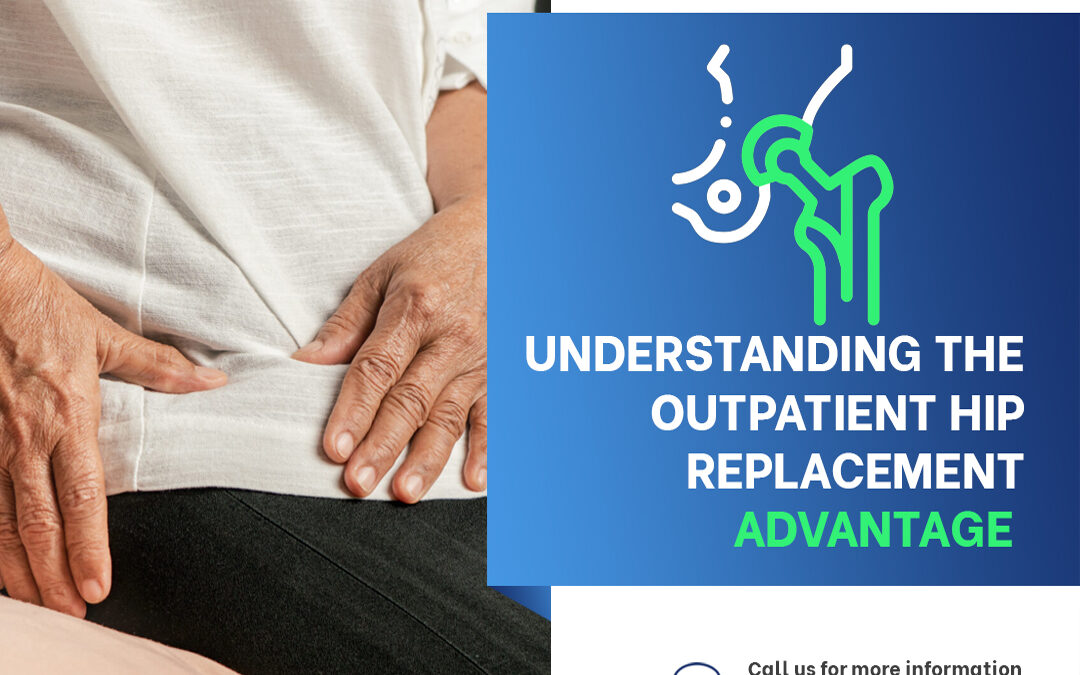If you’re dealing with hip pain related to arthritis or injury-related hip joint damage that is not responding to conservative therapies, hip replacement surgery can become an option that doctors recommend. Some of the barriers that keep people from electing hip replacement, even if it offers the best prospect for long-term relief, include wanting to avoid a lengthy hospital stay and a long, possibly difficult recovery.
Patients facing this decision should be aware of all potential options available, and with advances in the field of orthopedic surgery, outpatient hip replacement should be part of your decision-making process.
To help you learn more, we at Outpatient Joint Replacement Center of America — OJRCA — have put together the following information. To learn more about finding relief from hip pain, or for answers to any questions, don’t hesitate to reach out to a representative.
Outpatient Hip Replacement — A Basic Overview
Outpatient surgery, whether performed in a hospital or surgery center setting, is any procedure where the patient is not admitted for inpatient care. In the area of orthopedics, this type of surgery has become more common in recent years thanks to less invasive surgical techniques, advanced technology and new anesthesia and pain management protocols. Together, this enables patients to be mobile in a shorter time after surgery.
When performing outpatient hip replacement, a surgeon will access the hip joint, remove damaged joint surfaces and implant a replacement joint. By using techniques that help spare surrounding muscles and tendons these procedures are less invasive compared to traditional hip surgery.
The Main Advantages of Outpatient Total Hip Replacement
The goal of an outpatient procedure is for patients to experience less pain, need less narcotics in the postoperative phase and be up and moving faster to begin the all important recovery process.
With outpatient hip replacement, surgical patients can experience these significant advantages:
- A Faster Recovery: Outpatient hip replacement shortens the time patients spend under anesthesia. At OJRCA, we combine this with a postoperative pain management method that gets patients up and moving within one to two hours after the surgery has been completed. In the ensuing weeks, the smaller incisions and limited tissue damage can contribute to a faster healing process.
- Less Risk of Complication: Performing total hip replacement in an outpatient surgery center reduces a patient’s risk of infection as compared to having traditional surgery in a hospital setting.
- Better Outcomes: A rapid recovery protocol for increased mobility on a shorter time scale decreases blood clot risk along with other complications. Patients can then be on a path to rehabilitation, recovery and getting back to daily activities in a condensed time scale compared to traditional hip replacement.
It is also important to consider that outpatient hip replacement surgery offers a streamlined experience with increased convenience for the patient and family, avoiding an overnight hospitalization, patients can recover in the comfort of their home or a hotel with a family member or other care partner.
Determining if Outpatient Hip Replacement Is Right for You
For patients diagnosed with arthritis or any other condition that causes damage and degeneration to the hip joint, conservative therapy is typically the first line of treatment. Patients should be prepared to fully explore over-the-counter nonsteroidal anti-inflammatory drugs, alternating hot and cold therapy, physical therapy, and corticosteroid injections that relieve pain and inflammation. Another promising option is regenerative therapy, including platelet-rich plasma (PRP) injections designed to improve function and offer pain relief through the body’s natural healing process.
Candidates for outpatient hip replacement usually meet the following guidelines:
- Persistent or intermittent pain in the hip, groin, buttocks or thigh that does not improve after a full course of conservative treatment.
- A diagnosis of moderate-to-severe arthritis, with age-related osteoarthritis causing bone-on-bone contact being the most common form.
- Pain that is severe enough to limit daily activities or prohibit them altogether. This includes walking, climbing stairs, rising from a sitting position, entering or exiting a vehicle, dressing and performing cleaning and grooming activities.
For outpatient surgery, patients must also pass a medical screening for any conditions that would require additional monitoring and preclude an outpatient procedure.
After undergoing outpatient hip replacement surgery, patients will obtain thorough guidelines for recovery and rehabilitation. Expect to receive instructions for incision site care, resuming daily activities such as driving and signs to watch for that require medical care. Patients should expect follow up appointments to monitor progress and potential complications. Ensuring a positive outcome is highly dependent on patients following these postoperative instructions and completing any necessary physical therapy. This helps promote healing and proper functioning of the new artificial hip.
Minimally Invasive Hip Replacement at OJRCA
Board-certified orthopedic surgeon Dr. Philip Clifford, MD, and the experienced and knowledgeable OJRCA team have been helping patients with decades of combined experience. OJRCA’s highly unique multimodal pain management and anesthesia protocols enable outpatient hip replacement surgery that gets you back to the people and activities you love.
These methods can even benefit patients who do require an inpatient procedure due to the presence of medical conditions. At our advanced outpatient surgery center, Dr. Clifford and the OJRCA team can perform total hip replacement surgery for patients from all backgrounds and levels of activity.
To learn more about outpatient total hip replacement, contact us online today. You can also call us at 813-492-4607.


